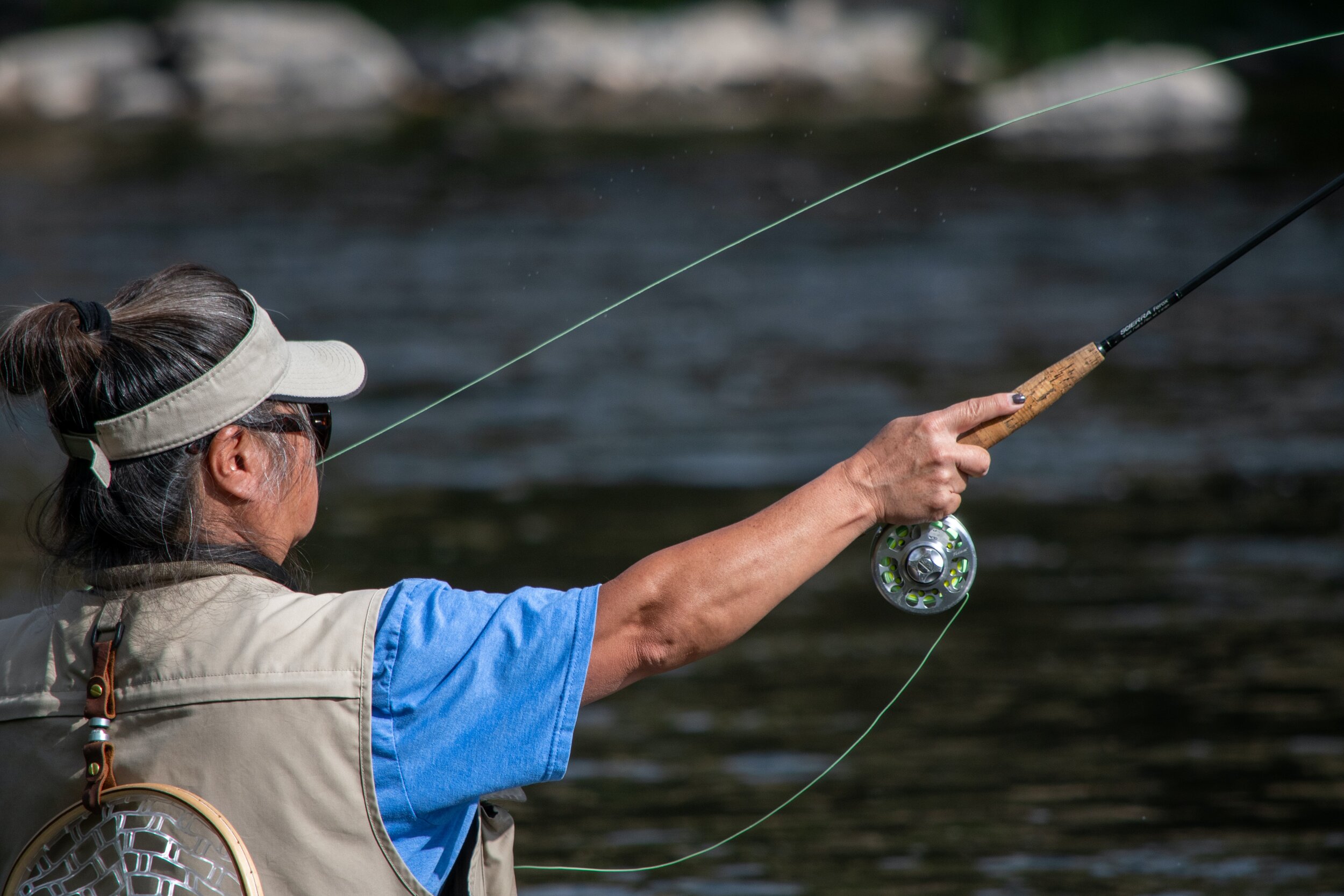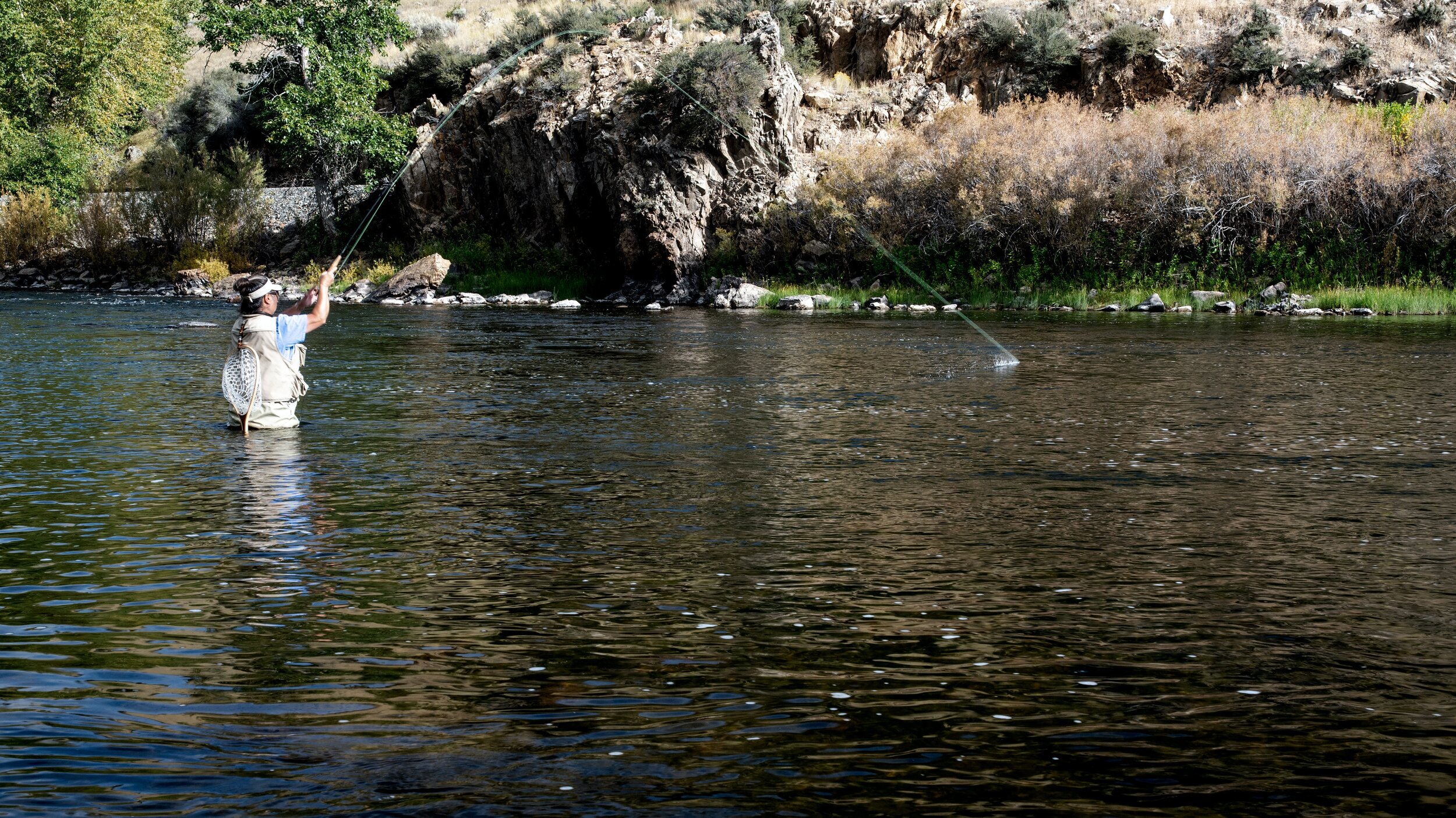WHAT IS FLY FISHING?
Fly Fishing Versus Traditional Fishing
Fly fishing is a unique and challenging pursuit. To someone unfamiliar with fly fishing versus more traditional techniques, there are several differences. Bait fishing, for example, typically has an angler use a lure that travels under the surface of the water. There are thousands of variations of lures and each travel at different depths and move in unique ways
Fly fishing, on the other hand, uses a tiny hook designed to look like a small insect on the surface of the water. As far as accessibility for newcomers, bait fishing is much easier to master and relies primarily on the pre-designed behavior of the bait used. Fly fishing is something akin to an art form and requires time to develop the instinctual skills necessary to be successful.
Why Fly Fish?
Fly fishing offers several benefits not found elsewhere. Since dry flies are lightweight and sit on the surface of the water, it's entirely up to the fly fishermen to create an alluring distraction for the fish below. Too much activity and the fish startle; not enough movement, and the aquatic creatures aren't interested.
With such a steep learning curve, you might wonder why an angler would take up fly fishing in the first place. With more challenge comes a higher reward. Traditional fishing can have first-timers landing a catch shortly after they cast out. However, with such precise fishing techniques required, fly fishing becomes more rewarding once we do land a bite.
While traditional fishing equipment works to fool the fish with less input from the angler, a fly fishing rig forces the angler themselves to try to trick the fish. This type of fishing forces us to think like fish and predict their behavior.
Fly Fishing Equipment
There are several differences in fly fishing gear versus traditional fishing equipment. One of the most significant changes an angler will notice is the fly's weight or lack thereof. The fly used in fly fishing is exceptionally lightweight and mimics an insect. The fly line itself can vary in specifications based upon rod recommendations and conditions. A heavy line or lighter one may be used and experience will help determine which one to select.
When you cast in bait fishing, for example, the lure typically has some heft to it, and therefore the weight of the lure offers easy casting. In fly fishing, you must learn to cast differently as the fly line itself is the weight used in casting. Not surprisingly, the most symbolic image of fly fishing is an angler in waders whipping around a significant amount of fishing line while casting.
With lure fishing, casting is a single back and forward movement allowing the lure's weight to carry the line out into the water. However, the fly fishing cast requires multiple actions that create what's called a loop in the fly line. The fly isn't traveling ahead of everything else, but rather the loop of the fly line is the driving force of the cast.
The fly rod is also different from traditional fishing as it usually is longer. These fly fishing rods must be longer to accommodate more flexibility during casting. As fly casting requires more than a single motion, such as the one used with spin rods, it's crucial the rod offers enough play and isn't overly rigid.
Another difference with fly fishing gear is that the angler must place their hand before the reel instead of after it. A longer rod and a much greater need for control require the hand placed higher up with fly fishing gear. Both the fly reels and rods found in fly fishing are engineered specifically for the sport.
Flies and Their Advantages
The artificial flies in fly fishing include materials such as feathers, fur, various beads, and wires. Some variations contain synthetic material and offer numerous color and shape options. Since many fish are scanning the water's surface for a flying insect to land, these artificial flies resemble something similar. However, some artificial flies can be wholly unique and not going for a natural look in the hopes a curious larger fish will attack.
Lures can come in the form of worms, small fish, plastic, and synthetic rubbery designs. Some argue that these materials aren't going to fool the top fish in the area. The oldest and largest fish can spot these devices and swim past them. Using natural materials such as feathers and fur provides a more authentic incentive for a more mentally acute fish. Each fly offers subtle movements and twinges as it rides along the surface of the lake. These movements are vital in mimicking real-life food sources and fooling the finned creatures.
These designs can become quite clever in their attempts to trick predatory fish. For example, when using a nymph fly, it sits just below the water's surface and can trap bubbles, convincing a fish that a larva is transforming into a fly. There are several options for dry flies that range anywhere from standard to ingenious.
Ready to Join Fly Anglers?
Fly fishing is such an incredible experience; it's difficult to put into words. Spending time in the tranquil, picturesque landscapes of the backcountry and the thrill of reeling in an impressive catch keeps fly anglers coming back.
Fly fishing provides a more significant challenge, more realistic flies, and more substantial control over your fly rod in water versus traditional fishing. For those who have begun the fly fishing journey, it becomes too difficult to go back to conventional methods. The steep learning curve of fly fishing involves learning to cast a fly rod, working the fly to best mimic but not startle the fish, and being patient. Once the proper skills develop, a deep appreciation for the sport follows. For first-timers, it may be best to consider booking a fly-fishing guide to learn the fundamentals.
Works Cited
B. (2019, November 19). Fly fishing line - the basics. Retrieved March 05, 2021, from https://blueridgemountainlife.com/fly-fishing-line-the-basics/
Gardner, A. (2013, January 05). The difference between fly fishing and spin fishing. Retrieved March 05, 2021, from https://thecatchandthehatch.com/the-difference-between-fly-fishing-and-spin-fishing/
J. (2020, July 12). Fly fishing vs bait fishing. Retrieved March 05, 2021, from https://practicalflyfishingskills.com/fly-fishing-vs-bait-fishing/
Losee, C. (2019, November 25). What is fly fishing. Retrieved March 05, 2021, fromhttps://theflyfishingbasics.com/what-is-fly-fishing/



